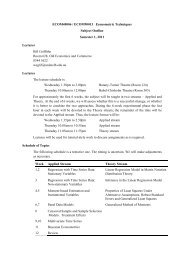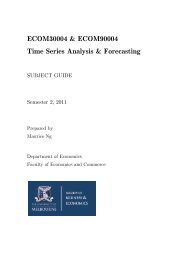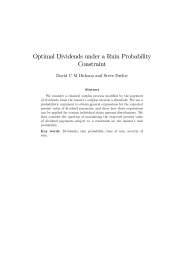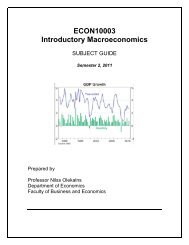A Model of Optimal Corporate Bailouts - Faculty of Business and ...
A Model of Optimal Corporate Bailouts - Faculty of Business and ...
A Model of Optimal Corporate Bailouts - Faculty of Business and ...
Create successful ePaper yourself
Turn your PDF publications into a flip-book with our unique Google optimized e-Paper software.
1.1 Sequential StructureThe model has three discrete time periods, t ∈ {0, 1, 2}, with no inter-temporal discounting,<strong>and</strong> three participants: a firm, a manager, <strong>and</strong> the government. The sequence is as follows:Time 0:• The government announces a bailout policy g, T 1 , T 2 , F G , the terms <strong>of</strong> whichare described below.Time 1: • The firm decides whether to invest in a project with initial cost, I 1 > 0.Time 2:• The project can be a “success,” yielding a gross pay<strong>of</strong>f R > 0, or a “failure,” yieldinggross pay<strong>of</strong>f 0.• The probability <strong>of</strong> success depends on managerial effort. We assume the probability<strong>of</strong> success is the manager’s effort level e 1 . Thus, the project fails with probability(1 − e 1 ). 5• If the project succeeds, the firm must pay the manager a contingent wage <strong>of</strong> w 1 ≥ 0<strong>and</strong> the government a tax <strong>of</strong> T 1 ≥ 0. 6 The game then ends.• If the project fails, the game transitions to time 2, described next.Effort should not be taken literally here. It is a modeling device to characterize a conflict<strong>of</strong> interest between managers <strong>and</strong> owners that needs to be remedied by paying a successcontingentwage. The conflict could equally well be a desire to build empires or not toperform unpleasant tasks (such as fighting bureaucracy or unions).• The government may readjust the remaining components <strong>of</strong> policy that are notyet sunk, g, T 2 , F G . This is tantamount to assuming that the government cannotcommit itself to a time-inconsistent policy.• The firm has a real option <strong>of</strong> either ab<strong>and</strong>oning the project or “restarting” it for anadditional investment <strong>of</strong> I 2 > 0. If the firm restarts, the firm can dismiss or keep themanager, F F = {FIRE, RETAIN}.• If the firm restarts, it may use a government-provided cash subsidy (or “bailout”)<strong>of</strong> g ≥ 0, which effectively underwrites a portion <strong>of</strong> the reinvestment costs. Inaddition, if the firm accepts the subsidy g, <strong>and</strong> it has not already fired the manager,the government can force dismissal <strong>of</strong> the manager, F G = {FIRE, RETAIN}.5 At the cost <strong>of</strong> tractability, one could introduce alternative algebraic specifications translating effort into successprobability. That said, because “effort” has no natural measuring unit, we lose little or no generality from ourcurrent setup, which uses convex effort costs <strong>and</strong> basic parameter restrictions (c > (R + S)) to bound 0 ≤ e 1 ≤ 1.6 As is customary in this literature, we do not allow the manager to purchase the firm <strong>and</strong> thus circumventthe main incentive problem. The nonnegativity <strong>of</strong> wages is the functional equivalent <strong>of</strong> limited liability for themanager. It is easy to introduce private managerial benefits if the project succeeds. In contrast to wages, privatebenefits are obtained even without managerial effort. Like wages, they accrue only upon success. The conclusions<strong>of</strong> our model remain unaltered, because the benefits simply serve to reduce the wage that the firm needs to paymanagers.8
















